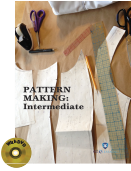Trade and Industrial Education

Pattern Making: Intermediate combines many different practical and visual skills with knowledge of specialized materials and techniques. Patterns are usually made of paper, and are sometimes made of sturdier materials like paperboard or cardboard if they need to be more robust to withstand repeated use. The process of making or cutting patterns is sometimes condensed to the one-word Patternmaking but it can also be written pattern making or pattern cutting. This book will introduce the knowledge and skills for those studying and/or working in pattern making industry.
About this Book
The information in this book consists of competencies that a person must achieve to be able to manufacture all types of solid, split and turned patterns and pattern component parts, including but is not limited to general engineering patterns, master patterns with multiple contraction, skeleton, frame and strickle, wheels, pulleys, chain sheaves, impellors, etc. It also include inspection, measurement and interpretation of drawings and repair procedures; setting up and operation of various specialized metalworking machines and utilization of precision measuring instrument in the operation and maintenance of melting equipment. This book covers all specifications interpreted from drawings, technical sketches and/or customer requirements.
About the Pattern Making Industry
An individual who creates patterns is often referred to as a patternmaker. These professionals are typically responsible for designing and creating the different patterns used to make different types in industry. Patterns can be cut out of several different materials, including fabric and plastic, but a thin paper known as pattern paper is typically the most common type of material. The purpose of a pattern is simple. Tracing around or cutting around pattern pieces for each of the different sections helps ensure this uniformity. A patternmaking career generally involves working deep in the industry. They may work to design and create patterns for unique pieces, for instance, or they may work closely with designers in order to create custom patterns. Before creating a pattern, a patternmaker must first have a good idea or image of what type of pattern needs to be made. In some cases, patternmakers must come up with these design ideas and sketches themselves. On the other hand, patternmakers might also be required to look at a sketch or picture of a certain product and create a pattern from that. In order to create a good pattern, a patternmaker must first decide what size the pattern will be. This can often be done by basing a new pattern on an existing pattern that is available in several different sizes. Some patternmakers are spatial and math whizzes, however, and they may be able to create a pattern simply by getting the measurements. These measurements are then used to create a pattern to make a perfectly sized product. Conceptualizing, measuring, drawing, and cutting out the pieces of a pattern, however, is not usually the end of a patternmaker’s job. Once a pattern is complete, the majority of patternmakers will then finalize the product. A training program in this area can catapult you into an exciting and fast paced career in the pattern making industry. Individuals interested in pursuing a career in patternmaking will usually need to attend a program in order to earn comprehensive skills in patternmaking.